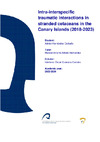Please use this identifier to cite or link to this item:
https://accedacris.ulpgc.es/jspui/handle/10553/131437
| Title: | Intra-interspecific traumatic interactions in stranded cetaceans in the Canary Islands (2018-2023) | Authors: | Hernández Carballo, Adrián | Director: | Arbelo Hernández, Manuel Antonio Quesada Canales, Ildefonso Óscar |
UNESCO Clasification: | 240119 Zoología marina 310907 Patología |
Issue Date: | 2024 | Abstract: | With the study of different cetacean populations worldwide, numerous aggressive encounters have been described, which we refer to as traumatic interactions. These are classified as intraspecific, if they occur between individuals of the same species, and interspecific, if they occur between different species. With this study we want to update the cases compatible with this pathological entity and expand the information on the injuries that occur in these encounters in the Canary Islands between 2018 and 2023. In this period 262 cetaceans stranded in the archipelago and 19 of them presented lesions compatible with traumatic interactions. All the cases presented multifocal severe vascular changes, 68,4% (13/19), bone fractures affecting mainly the thoracic region, 89,5% (17/19), acute tooth-rake marks, 31,6% (6/19), undigested food in the stomach and 10,5% (2/19) had lung perforation. The inter-tooth distance allowed us to identify the aggressor species. Six cases were compatible with killer whales (Orcinus orca) affecting four species: pigmy sperm whale (Kogia breviceps), dwarf sperm whale (Kogia sima), Atlantic spotted dolphin (Stenella frontalis) and short-finned pilot whale (Globicephala macrorhynchus). Another finding was postmortem shark bites in 26,3% (5/19) of the affected animals. In addition, we found signs of predation by sharks on two Atlantic spotted dolphins (Stenella frontalis). These animals presented semi-circular parallel multifocal tooth marks with inflammatory or vascular changes. Microscopically, skeletal muscle displayed acute degenerative changes in 89,5% (17/19), the cardiac muscle presented degeneration in 78,9% (15/19) of the cases, and skin tearing, with suppurative inflammatory infiltrate, necrosis and bacteria in 36,8% (7/19). Also hemorrhages and congestion in kidney, 36,8% (7/19), adrenal glands, 21,1% (4/19), brain, 42,1% (8/19) and liver, 15,8% (3/19) was observed. Shallow divers, with a good body condition and between Tenerife and La Gomera were more prone to these fatal interactions. Additionally, in this period, one animal died due to an accident during predation: a bottlenose dolphin (Tursiops truncatus) presented disinsertion of the larynx because of struggling while predating eels. | Department: | Departamento de Morfología | Faculty: | Facultad de Veterinaria | Degree: | Grado en Veterinaria | URI: | https://accedacris.ulpgc.es/handle/10553/131437 |
| Appears in Collections: | Trabajo final de grado |
En el caso de que no encuentre el documento puede ser debido a que el centro o las/os autoras/es no autorizan su publicación. Si tiene verdadero interés en el contenido del mismo, puede dirigirse al director/a o directores/as del trabajo cuyos datos encontrará más arriba.
Show full item recordPage view(s)
255
checked on Sep 27, 2025
Download(s)
134
checked on Sep 27, 2025
Google ScholarTM
Check
Share
Export metadata
Items in accedaCRIS are protected by copyright, with all rights reserved, unless otherwise indicated.
